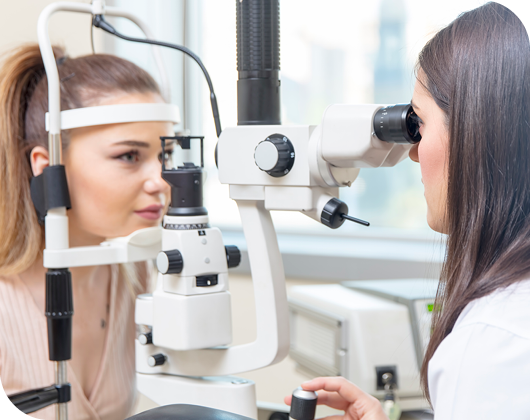
What is Glaucoma?
- Glaucoma is a condition that affects the optic nerve at the back of the eye. The optic nerve is a crucial component of vision as it is responsible for transmitting information from the eyes to the brain. In glaucoma, the optic nerve progressively deteriorates over time, leading to permanent vision loss. Eventually, it can lead to tunnel vision.
- Early detection of glaucoma is imperative to reduce the permanent effects of progressive vision loss. The quicker it is detected, the better chances of preserving vision.
- Glaucoma is related to intraocular pressure (pressure exerted by the eye). High intraocular pressures can lead to glaucoma, however even eyes with normal or low intraocular pressures can have glaucoma.

Which age groups are at high risk?
- People in higher age groups are more susceptible to this disease. People who are aged 80 years or older are 17 times more likely to have glaucoma, compared to people less than 50 years old. Having said that, glaucoma can still be found in people less than 50 years old.
What are Glaucoma symptoms?
- Most individuals with glaucoma do not notice any symptoms in the beginning. However as the condition progresses, peripheral vision loss can be noticed. Therefore, it is crucial to have regular eye check-ups to detect any glaucoma early on and treat it quickly.
- There are different types of glaucoma and the signs and symptoms can vary accordingly. Let’s have a look at the different types of glaucoma:
1. Open Angle Glaucoma
- In this type of glaucoma, there are no obvious symptoms early on. However, there is a progressive deterioration of peripheral vision. You can have blind spots form at the sides of your vision which can progress without noticing. Late, advanced stages of open angle glaucoma can lead to tunnel vision.
2. Acute Angle Closure Glaucoma
- Acute angle-closure glaucoma is a type of glaucoma where eye pressure suddenly increases to dangerous levels. This is due to a closure of the normal drainage pathway of fluid inside the eye. This type of glaucoma is a medical emergency and must be treated promptly to avoid permanent vision damage.
- The symptoms of acute angle closure glaucoma include red eye, eye pain, nausea, vomiting, severe headache, or blurred vision.
3. Secondary Glaucoma
- Secondary glaucomas are types of glaucoma that occur due to other eye diseases such as cataract or eye tumours.
4. Normal Tension Glaucoma
- This is a type of glaucoma where the eye pressure is still normal, however optic nerve damage is present. Symptoms of normal tension glaucoma are also not noticeable in the early stages, therefore, it is important to have your eyes tested regularly.

What causes Glaucoma?
- The exact cause of glaucoma is still unknown, however it is strongly related to eye pressure and other factors.
- Eye pressure is related to the amount of fluid inside the eye. This fluid is called aqueous humour and normally travels through the eye like a water pump system. When there is an overproduction of aqueous humour or a blockage in the drainage channels, the fluid can build up and cause eye pressure to increase. Increase in eye pressure can cause damage at the optic nerve, leading to progressive vision loss.
- There are other factors that can increase the risk of having glaucoma. These include:
- Family history (if one of your parents, siblings or extended relatives have glaucoma)
- Diabetes
- Myopia (short-sightedness)
- Smoking
How to treat or diagnose Glaucoma?
- Because the early symptoms of glaucoma are not noticeable, it is very important to have your eyes checked by an eye care professional to detect glaucoma. Glaucoma can be detected through retinal checks, eye pressure checks, corneal thickness checks, and visual field tests.
- Glaucoma is treated by lowering the eye pressure. The doctor may prescribe an eye drop or recommend laser or implant surgery. Surgery is generally reserved for severe cases of glaucoma or when eye drops do not work.
1. Eye Drops
- Anti-glaucoma eye drops will either reduce the fluid production, or increase the fluid leaving the eye to reduce the eye pressure. There are different types of anti-glaucoma eye drops, with different side effects.
2. Surgery
- - Surgery is generally reserved for severe cases of glaucoma or when eye drops do not work.
- - Laser surgery is used to increase the amount of fluid leaving the eye to reduce the eye pressure.
- - Microsurgery procedures also aim to increase the amount of fluid leaving the eye by implanting a device to create another fluid exit pathway. This creates a new channel to drain the fluid and reduce eye pressure.

Takeaway
- Regular eye testing can lead to early detection and treatment of glaucoma, to limit its effects on vision loss. The earlier the detection and treatment, the more vision that is able to be preserved.
